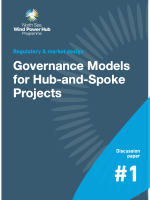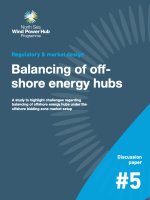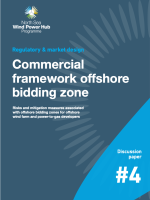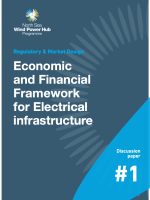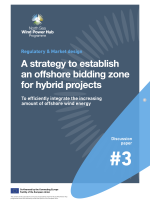Governance Models for Hub-and-Spoke Projects
Why read this report
To develop hub-and-spoke projects that connect and integrate large scale offshore wind, it is necessary to evaluate the roles and responsibilities of project stakeholders over project phases and assets. A governance model prescribes exactly that, however, given the complexity of the hub-and-spoke concept, a suitable and feasible comprehensive governance model is yet to be defined. Existing governance models can be used in developing a suitable tailor-made model for the hub-and-spoke concept. This paper addresses existing, conventional governance models for offshore wind, interconnection, natural gas, and energy storage; for Denmark, Germany, the Netherlands, and the UK. Moreover, an overview of the latest trends and developments in governance models for offshore wind, hydrogen assets and infrastructure, and cross border infrastructure. Using these insights, a description of a suitable and feasible governance model for a first hub-and-spoke project is presented in combination with decisions that need to be taken. Finally, recommendations of next steps are provided.
Highlights
The novel approach of hub-and-spoke projects calls for a re-assessment of roles and responsibilities in planning, ownership, and operation of assets.
The centralised approach seems best suited and can result in benefits like system planning and design optimization, economic efficiency, a fit with current and future policies, and speed of implementation.
A potential hub-and-spoke governance model system planning can be done by a consortium of national TSOs, ownership and operation of infrastructure assets may be assigned to national entities or TSOs. While this is similar to the status-quo, decisions need to be taken by governments on new aspects such as the hub foundation, system planning responsibility and interconnectors between national hubs.
Executive summary
The hub-and-spoke concept offers a solution to the challenge of integrating offshore renewable energy to onshore energy systems in a cost-efficient manner, assuring further interconnectivity and security of energy supplies.
To develop hub-and-spoke projects that connect and integrate large scale offshore wind, it is necessary to evaluate the roles and responsibilities of project stakeholders over project phases and assets. A governance model prescribes that. However, given the novelty of the hub-and-spoke concept, a suitable and feasible comprehensive governance model, suitable specifically for hub-and-spoke projects, is yet to be defined.
Existing governance models, defined separately for offshore wind infrastructure, interconnection, and gas network development, typically can be categorised as centralised or decentralised. In a centralised governance model, system planning, ownership and operation is assigned to a national entity, usually a (gas or electricity) TSO. In a decentralised governance model, ownership of infra- structure assets is attained by a commercial entity.
While lessons can be learned from the existing governance models for offshore wind infrastructure, interconnection, and gas network development, hub-and-spoke projects have unique characteristics that are different from conventional projects. First, offshore wind transmission to shore and interconnection between countries are combined in a single project. In addition, hub-and-spoke projects combine both electricity as well as hydrogen infrastructure. Finally, conversion and storage of electricity is enabled on hubs to provide flexibility to the operators.
Recent publications by the European Commission describe forthcoming developments in offshore wind and hydrogen projects. While none of these publications clearly and undeniably endorses a centralised model over a decentralised model, the emphasis on integrated grid planning and strong oversight by the European Commission and ACER indicate the desire for national and European coordination in grid planning and development.
While a wide variety of governance models is possible, the North Sea Wind Power Hub (NSWPH) consortium provides an example of a governance model by extending the currently applied governance models in the relevant countries. As such, stemming from the currently applied governance models, the following allocation of roles and responsibilities could be envisioned:
-
System planning: consortium of national electricity TSO and/ or gas TSO/ national state-owned entity to ensure coordinated and future proof infrastructure development.
-
Development and ownership of the hub foundation.
-
Ownership and operation of transmission cables from hub to shore: national electricity TSO.
-
Ownership and operation of interconnectors: shared between national electricity TSOs.
-
Ownership and operation of hydrogen transmission pipelines: relevant national gas TSOs or network companies.
-
Ownership and operation of other on-hub assets (such as energy storage and electrolysers): privately owned (e.g. commercial developers or gas network companies).
To realise a first hub-and-spoke project, national governments must take decisions on the exact configuration, ownership allocation of the hub foundation, and funding and cost recovery mechanisms. National governments need to form decisions on the allocation of responsibility for each element of the chain, the regulatory regime for interconnectors, funding and cost recovery for cross border cooperative projects and phasing of offshore grid build out. While some decisions require intergovernmental agreements (e.g. interconnectors), other decisions can be made nationally.
